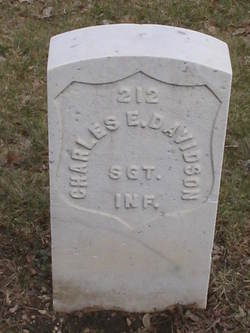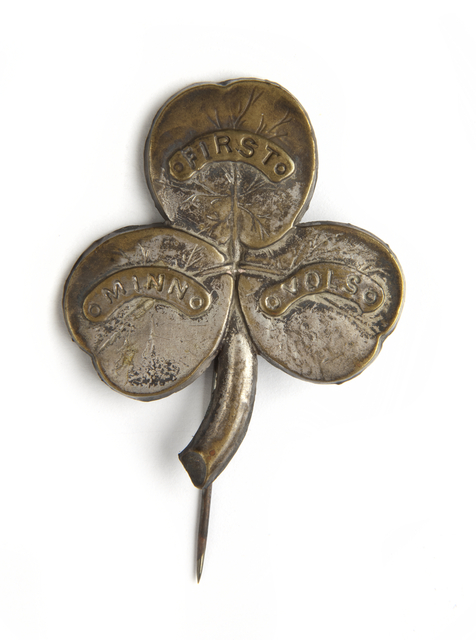On April 12, 1858, he married Olive A Hall in Richmond, Wisconsin. She was born in 1833 in New York and was a year older than Charles. In an advertisement he placed in the Faribault Central Republican newspaper, in early 1861, Davison described himself as "Architect & Carpenter, for homes, outhouses, barns, etc."
Davison was 27 years old, when he enlisted. He stood 5' 7 1/4" tall, had a light complexion, hazel eyes and light colored hair. He was placed in Company G, which was made up of men from the Faribault and Red Wing area. He began sending back correspondence to the Central Republican in Faribault. They published the letters and identified the author by just his initial "D". Sometimes men who wrote to the papers back home preferred to remain unknown, because some of what might be said could have a negative tone to it, and the parties being mentioned may take offense against the writer. Charles was appointed a sergeant, in Company G, on Aug 9, 1861, reduced to the ranks on Sept 8, 1861, but reinstated on October 3rd. We don't know the reason why or if it had anything to do with his reporting to the folks back home.
Davison was wounded at the Battle of Bull Run. He managed to get off the field and not be captured. He continued to serve but may not have fully recovered from the wound or he may have become sick like many of the men did, due to the tough living conditions. He was sent to a few hospitals to recover. One of his last correspondences was from the Craney Island Hospital in Virginia, on Aug 26, 1862. He said, "Speaking for myself, it is the first place I have been, when as a sick man I could be comfortable, and I have no desire to for change until I am able to join my regiment."
Unfortunately he never made it back to the unit. On Oct 20, 1862, he was admitted to the US Army General Hospital located on Bedloe's Island, in New York harbor. He was suffering from debility. He died on November 16, 1862.
Sources:
Letter written by Phineas Dunham to his mother, Nov 24, 1862, Military Pension file, Phineas Dunham, Natl Archives, Wash DC.
Bibliography; Early Pioneers and Indians of Minnesota and Rice County
Lillie Berg, 1959 San Piedro California
The Central Republican, Faribault, Mn, July, 1861-Aug, 1862.
Roster of the First Minnesota Infantry, 1910.
On April 12, 1858, he married Olive A Hall in Richmond, Wisconsin. She was born in 1833 in New York and was a year older than Charles. In an advertisement he placed in the Faribault Central Republican newspaper, in early 1861, Davison described himself as "Architect & Carpenter, for homes, outhouses, barns, etc."
Davison was 27 years old, when he enlisted. He stood 5' 7 1/4" tall, had a light complexion, hazel eyes and light colored hair. He was placed in Company G, which was made up of men from the Faribault and Red Wing area. He began sending back correspondence to the Central Republican in Faribault. They published the letters and identified the author by just his initial "D". Sometimes men who wrote to the papers back home preferred to remain unknown, because some of what might be said could have a negative tone to it, and the parties being mentioned may take offense against the writer. Charles was appointed a sergeant, in Company G, on Aug 9, 1861, reduced to the ranks on Sept 8, 1861, but reinstated on October 3rd. We don't know the reason why or if it had anything to do with his reporting to the folks back home.
Davison was wounded at the Battle of Bull Run. He managed to get off the field and not be captured. He continued to serve but may not have fully recovered from the wound or he may have become sick like many of the men did, due to the tough living conditions. He was sent to a few hospitals to recover. One of his last correspondences was from the Craney Island Hospital in Virginia, on Aug 26, 1862. He said, "Speaking for myself, it is the first place I have been, when as a sick man I could be comfortable, and I have no desire to for change until I am able to join my regiment."
Unfortunately he never made it back to the unit. On Oct 20, 1862, he was admitted to the US Army General Hospital located on Bedloe's Island, in New York harbor. He was suffering from debility. He died on November 16, 1862.
Sources:
Letter written by Phineas Dunham to his mother, Nov 24, 1862, Military Pension file, Phineas Dunham, Natl Archives, Wash DC.
Bibliography; Early Pioneers and Indians of Minnesota and Rice County
Lillie Berg, 1959 San Piedro California
The Central Republican, Faribault, Mn, July, 1861-Aug, 1862.
Roster of the First Minnesota Infantry, 1910.
Family Members
Advertisement
Records on Ancestry
Sponsored by Ancestry
Advertisement












